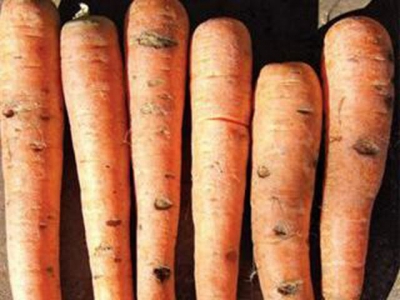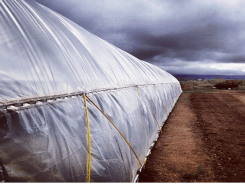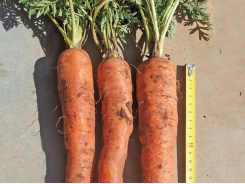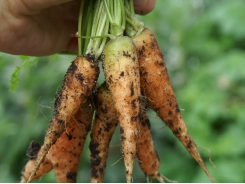Carrot root diseases

Your carrot crop is looking good. You can almost hear the money cascading into your bank account. Then you harvest it – and all that profit vanishes.
Cavity spot, a symptom of Pythium. Photo: Bill Kerr
A root disease has spread through your land, and your carrots are seriously degraded. The main culprits here are cavity spot and Rhizoctonia. Both are soil-borne and can manifest very close to harvest, causing shock and disappointment.
Although both are often referred to as ‘cavity spot’, each is caused by a different pathogen and has a different appearance. Cavity spot is caused by species of Pythium fungus – usually P violae, P sulcatum and P ultimum. It produces round or oval cavities on the roots. Apart from downgrading the roots due to physical appearance, it greatly impairs shelf life.
Like Rhizoctonia, this disease prefers soil that is cool, but not too cold. It thrives in the semi-anaerobic conditions created by heavy rainfall and in saturated soil with lower oxygen levels. Soils that are overworked or cultivated when wet are particularly vulnerable.
Many of South Africa’s summer rainfall areas experience a lot of rain late in the season, making soil preparation difficult. However, if carrots are sown too late, yield may be affected. Consequently, some farmers throw caution to the wind and cultivate and plant in soil that’s too wet – and pay the price with an outbreak of cavity spot or Rhizoctonia.
Rather prepare beds well before summer to make provision for the possibility of a wet autumn. All you need is a day or two of dry weather, then you can lightly prepare the surface to accommodate the planter.
High organic content
These pathogens prefer an acid soil, so liming can be a help. Where the disease is a major hazard, increase the soil-water pH to about 8 or a KCL pH of 7,2. Most farmers would avoid bringing the soil to this level of alkalinity. The organic status of the soil also plays a major role. A soil with a high organic content and good physical structure is perhaps the most successful remedy for cavity spot.
Ridomil Gold applied after planting can be effective in combating cavity spot caused by P violae, but is virtually ineffective when P sulcatum is the culprit. The soil organisms that naturally break down this product can multiply fairly rapidly and so it becomes less effective with frequent use.
If your crop has this disease, be careful not to plant carrots again too soon afterwards. As an extra precaution, plant this land when there’s less likelihood of the disease developing – when the soil is warmer and drier. As far as I’m aware, there are no carrot varieties resistant to cavity spot. But some are more tolerant than others. If symptoms develop, harvest as soon as possible, as the disease can spread rapidly at this stage.
Black transverse lesions on carrots
Rhizoctonia requires many of the same conditions in order to develop. However, Rhizoctonia forms black transverse lesions on the roots. When I started cultivating my plot for plant breeding, carrots would show such severe Rhizoctonia symptoms that I had to plant much larger quantities of each variety in order to select enough clean roots for transplanting for seed production.
After a few years of tilling less and improving the structure and organic content of the soil, I found that the disease had disappeared. For years I have not had a single root with symptoms. The fact is, improving the soil condition can make a huge difference to the health and productivity of all our crops.
Related news
Tools

Phối trộn thức ăn chăn nuôi

Pha dung dịch thủy canh

Định mức cho tôm ăn

Phối trộn phân bón NPK

Xác định tỷ lệ tôm sống

Chuyển đổi đơn vị phân bón

Xác định công suất sục khí

Chuyển đổi đơn vị tôm

Tính diện tích nhà kính

Tính thể tích ao




 Other carrot problems
Other carrot problems  Eelworms love carrots
Eelworms love carrots